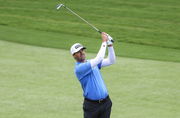
Imago
Credits: Imago

Imago
Credits: Imago
Remember the chaos at the WM Phoenix Open when fans showered the course with beer after a hole-in-one on the 16th? Koepka brought that same energy to LIV Golf Adelaide, acing the par-3 “Watering Hole” as the crowd erupted — drinks flying, music blasting, and the moment instantly becoming one of golf’s wildest celebrations. Recently, Jessica Korda took this similar aspect to social media as a reminder to people on this basic etiquette.
Watch What’s Trending Now!
She urged people to “clean up your mess.” While on a golf course, as she has personally seen many people just walking away after they make their shots, she adds, “There’s been way too many times that I have seen, especially young kids, not doing this, and it blows my mind.” Jessica Korda, witnessing young kids lacking this basic etiquette, recalls her junior days and how fixing the course and taking care of it was instilled into her routine.
“It was not only to be fixed, the mess we had just made, but we also made sure that we left it nice,” Jessica Korda recalls, noting how her AJGA junior program even held “take-care-of-the-golf-course parties.” She believes these habits should be passed on, “trickling over to junior golf and then obviously in the professional league.”
ADVERTISEMENT
For Korda, course care goes beyond responsibility — it’s about respect for the game. “We also made sure that we left it nice for the next people that were gonna be practising,” she adds. Repairing divots, fixing pitch marks, and raking bunkers instill discipline, attention to detail, and respect — lessons that extend well beyond golf.
Top Stories
Phil Mickelson Backs Hollywood Actor Amid Criticism Surrounding His Daughter’s Pro Tour Debut

Victor Perez’s LIV Golf Move Doesn’t Sit Right With Golf Fans: ‘Another Victim’

Jordan Spieth Issues Career Advice to Justin Thomas After Back Surgery Announcement

Lydia Ko, Charley Hull Join LPGA Pro in Mourning Her Father’s Tragic Demise: ‘Sorry for Your Loss’

Iconic Augusta Hooters That John Daly Made Famous Gets Demolished Overnight

The Bigger Picture: Course Care Is Every Golfer’s Responsibility
Jessica Korda’s words echo the problem with the new generation of golfers, many of whom blatantly neglect the simple responsibility of maintaining the course. The USGA has even made a post on how unrepaired ball marks can take weeks to heal, leaving scars that affect putting surfaces and increase the risk of turf disease. This has been a rising issue since the pandemic, as more golfers are getting into the sport and many people are using public golf courses. Sean Fairholm, a journalist at GolfSpy, adds on how “the increase in unfixed ball marks over the past few years has officially gotten out of control. “
ADVERTISEMENT
“An unrepaired or incorrectly repaired ball mark will take weeks for each blemish to repair instead of days,” is what a superintendent from BlackSheep golf club added. This is due to how many golfing clubs operate on tight budgets, and it would allow the crew to focus more on the turf health rather than patchwork repairs. Sometimes, they have to resurface and re-seed a whole area if ball marks aren’t repaired properly.
Korda isn’t the only one who is voicing her frustrations in this issue; Phil Mickelson has called the neglect of bunkers and marks “disrespectful” numerous times. Paige Spiranac even went viral for her take on fixing ball marks. She said on Twitter, “If you can’t fix your ball mark on the green, you shouldn’t be allowed to play. It takes two seconds to do and requires no skill.”. Recently, Rory McIlroy led by example during the Ryder Cup. He returned to repair a damaged green after his round when he threw his golf club in frustration, showing people that even during bad games, you never disrespect the course.
ADVERTISEMENT
Hot take. If you can’t fix your ball mark on the green you shouldn’t be allowed to play. It takes two seconds to do and requires no skill.
— Paige Spiranac (@PaigeSpiranac) June 21, 2025
The proper technique of fixing a ball mark is simple: insert a repair tool outside the dent, push the edges inward (never lift), and smooth with a putter. It is important to know that if done incorrectly, it will cause more damage to the course and might take weeks, sometimes months, to heal, so it’s crucial to have proper technique.
Many programs and golf courses even encourage fixing one extra mark for good measure as a habit, which can help preserve a golf course.
ADVERTISEMENT
So why don’t more players do it? Many times, it’s a lack of awareness or simply rushing through a round. That’s why players like Jessica Korda ask for parents and coaches to make sure that these habits are drilled into young players from their junior days. Because ultimately, this isn’t just about etiquette, it’s about safeguarding the future of the game.
ADVERTISEMENT
ADVERTISEMENT
ADVERTISEMENT

